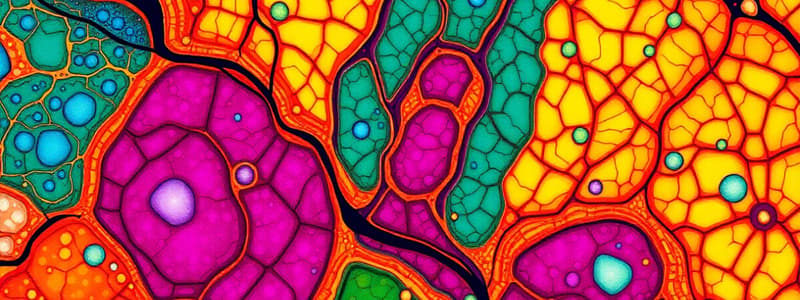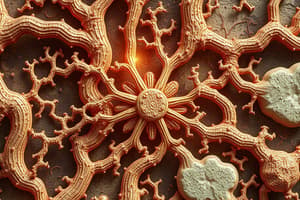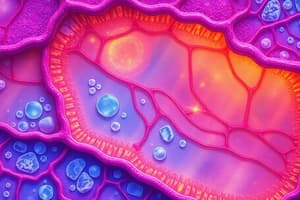Podcast
Questions and Answers
What are the four basic types of animal tissue?
What are the four basic types of animal tissue?
Epithelial, muscular, nervous, and connective tissue.
Name the primary cell types found in connective tissue proper.
Name the primary cell types found in connective tissue proper.
Fibroblasts, adipocytes, plasma cells, mast cells, and macrophages.
What is the main function of fibroblasts in connective tissue?
What is the main function of fibroblasts in connective tissue?
Fibroblasts are important for the synthesis of collagen fibers and ground substances.
Differentiate between unilocular and multilocular adipocytes.
Differentiate between unilocular and multilocular adipocytes.
What is the role of the extracellular matrix (ECM) in connective tissue?
What is the role of the extracellular matrix (ECM) in connective tissue?
What is the significance of the rough endoplasmic reticulum in fibroblasts?
What is the significance of the rough endoplasmic reticulum in fibroblasts?
Explain how connective tissue integrates with other tissue types in the body.
Explain how connective tissue integrates with other tissue types in the body.
Identify the germ layer from which connective tissue is derived.
Identify the germ layer from which connective tissue is derived.
What is the primary morphological characteristic of multilocular adipocytes?
What is the primary morphological characteristic of multilocular adipocytes?
How does the nucleus of unilocular adipocytes differ from that of multilocular adipocytes?
How does the nucleus of unilocular adipocytes differ from that of multilocular adipocytes?
What is the role of rich mitochondrial presence in multilocular adipocytes?
What is the role of rich mitochondrial presence in multilocular adipocytes?
Identify one key function of plasma cells in the immune system.
Identify one key function of plasma cells in the immune system.
What type of granules do mast cells contain, and what are their components?
What type of granules do mast cells contain, and what are their components?
Explain the process through which monocytes become macrophages.
Explain the process through which monocytes become macrophages.
What distinguishes the staining characteristics of plasma cells?
What distinguishes the staining characteristics of plasma cells?
Describe the capillary network surrounding unilocular adipocytes.
Describe the capillary network surrounding unilocular adipocytes.
Flashcards
Multilocular Adipocytes
Multilocular Adipocytes
Small, spherical cells (15-25 µm) with numerous lipid droplets of varying sizes. Round nucleus centrally located. Rich in mitochondria and cytochrome. Found predominantly in birds, rodents, and newborn mammals (thyroid glands and renal hilus).
Unilocular Adipocytes
Unilocular Adipocytes
Large, spherical to polyhedral cells (25-100 µm) with a single, large lipid droplet (lipoblast). Flattened nucleus displaced to the periphery (signet ring). Stabilized by microfilaments. Color determined by carotenoids.
Macrophage
Macrophage
Derived from hematopoietic stem cells, also known as histiocytes. Circulate as monocytes and differentiate into macrophages (diapedesis) . Exist as resident macrophages in specific organs (Kupffer cells in liver, Langerhans cells in skin, dust cells in lungs).
Mast Cell
Mast Cell
Signup and view all the flashcards
Plasma Cell
Plasma Cell
Signup and view all the flashcards
Connective Tissue
Connective Tissue
Signup and view all the flashcards
Connective Tissue Proper
Connective Tissue Proper
Signup and view all the flashcards
Fibroblast
Fibroblast
Signup and view all the flashcards
Adipocyte
Adipocyte
Signup and view all the flashcards
Extracellular Matrix (ECM)
Extracellular Matrix (ECM)
Signup and view all the flashcards
Ground Substance
Ground Substance
Signup and view all the flashcards
Fibers
Fibers
Signup and view all the flashcards
Study Notes
Connective Tissue
- Connective tissue is one of four basic animal tissues, along with epithelium, muscle, and nerve.
- It integrates three basic animal tissues to function physiologically.
Connective Tissue Classification
- Connective tissue (CT) is classified into CT Proper and Specialized CT.
- CT Proper is further categorized into Loose CT and Dense CT.
- Dense CT is then divided into Dense Regular Collagenous CT, Dense Regular Elastic CT, and Dense Irregular CT.
- Specialized CT includes Cartilage, Bone, and Blood.
Connective Tissue Proper
- Derived from the mesoderm of embryonic germ layers.
- Differentiated from pluripotent mesenchymal cells.
- Composed of cellular components and extracellular matrix (ECM).
- Cellular components include fibroblasts, adipocytes, plasma cells, macrophages.
- ECM consists of fibers (e.g., collagen, elastic) and ground substances.
Fibroblast
- Most abundant and widely distributed in animal tissues.
- Crucial for synthesizing fibers (collagen and elastic) and ground substance (GAGs, proteoglycans, glycoproteins).
- Elongated, fusiform cells with irregular cytoplasmic projections.
- Nucleus is oval, darker-stained, with numerous euchromatin.
- Cytoplasm is pale and stains weakly eosinophilic.
- Contains abundant rough endoplasmic reticulum (rER) and Golgi apparatus (GA).
Adipocyte
- Crucial for lipid synthesis and storage.
- Two types: multilocular (brown) and unilocular (white).
- Multilocular adipocytes are small, spherical, containing numerous lipid droplets. Nucleus is round and centrally located. Contain numerous mitochondria and cytochrome. Innervated with adrenergic nerve fibers and dense capillaries. Predominantly found in birds, rodents, and newborn mammals (thyroid glands and renal hilus).
- Unilocular adipocytes are large, spherical to polyhedral. Contains a single large lipid droplet (lipoblast). Lipid droplet stabilized by microfilaments. Its nucleus is flattened and displaced to the periphery (signet ring). Characterized by small Golgi apparatus, few mitochondria, sparse rER, and abundance of free ribosomes. Plasma membrane has insulin, growth hormone, cortisol, and noradrenaline receptors. Surrounded by dense capillary network and collagen type III (reticular fiber).
Plasma Cell
- Differentiated B-lymphocytes involved in humoral immunity.
- Morphologically large, ovoid cells (20 µm).
- Nucleus is eccentrically located, with heterochromatin concentrated in a peripheral clump (clock face, spoke wheel, or cartwheel).
- Cytoplasm stains intensely basophilic, with well-developed rER containing closely packed cisternae.
- Contains few scattered mitochondria and numerous free ribosomes.
- Found in lamina propria of gastric and enteric mucosa.
Mast Cell
- Large, ovoid cells (20-30 µm) found in loose connective tissue.
- Nucleus is centrally located, with an ellipsoid shape.
- Cytoplasm is basophilic.
- Contains numerous granules (0.3-0.8 µm) with metachromatic staining.
- Granules contain histamine, heparin, and chemotactic factors (ECF and NCF).
- Express IgE receptors, involved in hypersensitivity type I.
- Long lifespan (weeks to months).
Macrophage
- Derived from hematopoietic stem cells; also known as histiocytes.
- Circulating monocytes differentiate into macrophages (diapedesis).
- Resident macrophages include Kupffer cells, Langerhans cells, and dust cells.
- Phagocytose damaged, dead cells, cellular debris, and antigens.
- Serve as antigen-presenting cells (APCs) via MHC class II.
- Amoeboid, irregular cell morphology (10-30 µm).
- Possess long, blunt projections (pseudopodia).
- Activated macrophages show prominent membrane folding.
- Nucleus is indented (kidney-shaped).
- Cytoplasm is basophilic with small vacuoles and granules.
- Contains abundance of lysosomes (azurophilic granules).
- Well-developed Golgi apparatus and rough endoplasmic reticulum.
Studying That Suits You
Use AI to generate personalized quizzes and flashcards to suit your learning preferences.




